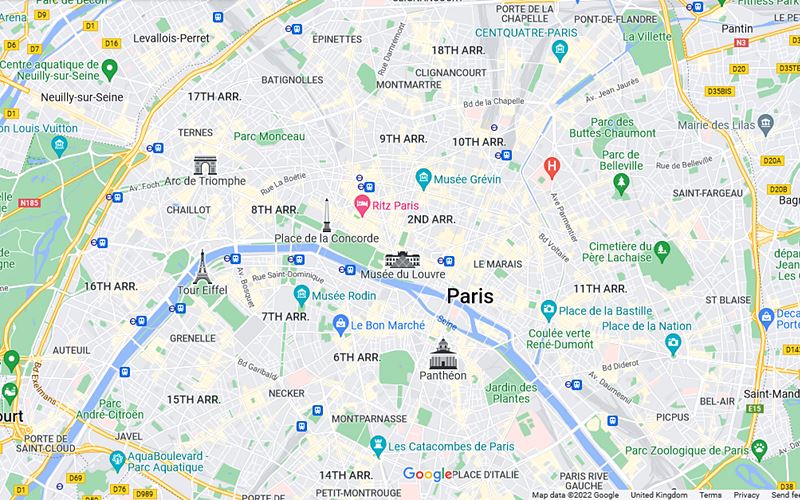Some links on this page are affiliate links. They may generate revenue for this site but there’s no extra cost to you if you make a purchase. More on affiliate links
The 7 nicest and coolest areas of Paris to visit and stay
Paris is one of those great cities that’s nearly on everyone’s bucket list. After all, the French capital is a thriving hub of attractions. The city is home to beautiful architecture, historic sites, world-famous monuments, renowned museums, culinary diversity, great shopping and much more.
With a plethora of things to see and do, many tourists hop from one attraction to another. But don’t forget to explore the Paris neighbourhoods. Each is unique with its own personality and charm. That said, most parts of Paris are well-connected by the Metro trains so you can easily visit the neighbourhoods.
Wondering which are the best neighbourhoods in Paris to visit? Here are the 7 top picks that are the most memorable. Besides, they are great locations to stay, whether it’s your first visit or have been to the city before. So here’s the guide to the best neighbourhoods in Paris to walk around and explore.
YOU MAY ALSO LIKE
Île de la Cité

- Location: Centre of Paris on the River Seine
- Metro station: Cité (Line 4)
Île de la Cité (City Island) is a small island on the River Seine. This is the historic heart of Paris where the city began, going back 2,300 years when the Gauls settled. Clovis I, who was the first King of the Franks, built his palace on the island in the 6th century and established Paris (the island back then) as the capital.
Île de la Cité is shaped like a ship and linked by 4 bridges to Le Marais in the north and another 4 to the Latin Quarter in the south. Another bridge links with the smaller island of Île Saint-Louis in the east. Île de la Cité is not a large area, only 0.22 sq km (0.40 sq miles). You can easily walk around and explore this historic island.
The 14th-century Notre Dame Cathedral is a lovely example of French Gothic architecture. The exterior is intricate featuring facades, carved portals, lofty towers and soaring spires. A fire in 2019 caused serious damage to the cathedral. Off-limits at the moment while under restoration but you can watch the cathedral from a distance.
A short walk from the Notre Dame Cathedral is Sainte-Chapelle, a 13th-century chapel going back to King Louis IX during the French Capetian dynasty. A majestic Gothic building and the interior is even more stunning. It’s richly adorned and the most striking feature is the over 1,000 stained glass windows, some of the finest in the world!

La Conciergerie is another Gothic architecture from the 13th century. It was once the royal palace of the French kings. During the French Revolution, nearly 3,000 prisoners including Marie-Antoinette were imprisoned and tried here, and later executed. The palace is now a museum and includes a recreation of the prison chambers.
Marché aux Fleurs is the city’s most famous flower market and right here on Île de la Cité. It’s a colourful scene of flowers including roses, peonies, lilac, tulips, irises, azaleas and dahlias. There are even exotic plants such as orchids, cactuses and other tropical flora. Tourists are always welcome and you don’t have to buy.
Square du Vert Galant is a small pretty park on the western tip of the island. A pleasant spot to laze and admire lovely views of the River Seine. Place Dauphine is a public square before the park. Historic 17th-century architecture surrounds the square and is occupied by cute cafés and restaurants where you can relax and enjoy a leisurely meal.
Quartier Latin

- Location: 4th and 5th arrondissements
- Metro stations: Cluny La Sorbonne (Line 10), Saint-Michel Notre-Dame (Line 4), Place Monge (Line 7)
Quartier Latin (Latin Quarter) is a step back in time to the Middle Ages. This Paris neighbourhood gets its name from the College of Sorbonne when in the 13th century it taught in the Latin language. The quarter is still the centre of student life in Paris, home to several eminent institutions of higher learning including Sorbonne University.
The Quarter is directly south of the island of Île de la Cité. A big part is in the 5th arrondissement and the rest in the 6th. The Quarter is the oldest district in Paris though much was torn down and redeveloped by Baron Haussmann in the 19th century. That said, some areas were left untouched and today the oldest parts of the quarter.
The main area of the “old” Latin Quarter is roughly within the limits of the River Seine, Boulevard St-Michael and Boulevard St-Germain. The area is a world apart from the rest of the quarter with an ancient character and old-world charm. Within is a packed maze of narrow streets, cobblestoned lanes, antique buildings and medieval churches.
The “old” Latin Quarter is more than history but also a lively place with entertaining nightlife. Tucked away in the corners are a host of small shops as well as quaint cafés and restaurants to enjoy the time. And it’s a delightful stroll along the River Seine, not to mention the picturesque scene of Île de la Cité on the river.

Rue Mouffetard was spared from Baron Haussmann’s redevelopment and today one of the oldest streets in Paris. Independent shops pack this narrow bustling street. Every morning except Mondays, the road turns into a street market crammed with stalls selling from fresh produce to gourmet foods.
On the southeastern edge of the Latin Quarter is Jardin des Plantes, a stunning botanical garden. On the grounds is Musée National d’Histoire Naturelle, France’s national natural history museum. Another major sight is the Pantheon, an 18th-century architectural gem and the final resting place for France’s most eminent citizens.
For fans of indie and classic films, the quarter is loaded with more than 15 arthouse cinemas. Tickets at a typical cinema cost around €12 but a third less for the cinemas here. Le Champo on Rue des Ecoles is a popular cinema. Two more nearby favourites, on Rue Champollion, are Filmothèque du Quartier Latin and Reflet Médicis.
St-Germain-des-Prés

- Location: 6th arrondissement
- Metro stations: St-Germain-des-Prés (Line 4), Mabillon (Line 10), Odeon (Lines 4, 10)
St-Germain-des-Prés is on the west side of the Latin Quarter within the boundaries of the River Seine, Rue Mazarine, Rue du Four and Rue des St-Perés. Chic and trendy, St-Germain-des-Prés is home to refined buildings and charming streets. To top it all up are the designer boutiques, quaint cafés and restaurants.
Boulevard St-Germain is the main thoroughfare and passes Eglise de St-Germain-des-Près, an 11th-century church. The boulevard is the main part of the walk but you shouldn’t miss the hidden gems on the side streets. The best place to start exploring is from St-Germain-des-Prés Metro Station, near the church.
St-Germain-des-Près is the focal point of the 6th arrondissement. It’s the classic Paris on the postcard that tourists often think about. The neighbourhood is rich in heritage from centuries of history and culture. There’s also an air of aristocracy. But there’s also an energetic vibe and Bohemian spirit.
Eglise de St-Germain-des-Près is the oldest church in Paris, originally an abbey and once one of the richest in France. The church features a lofty bell tower and a short visit inside is worth the time. The interior features an ornate nave spruced by marble columns. And the gorgeous paintings adorning the walls are a legacy of Norman art.

Cafés and restaurants in the quarter were once regular haunts for writers, artists and intellectuals like Hemingway, Picasso and Sartre. The legendary Café de Flore, Les Deux Magots and Brasserie Lipp are still around in their retro settings. Sit where the elites once sat, spending their time in thought and people-watching.
Cour du Commerce-St-André is a cobblestoned passage near the Odeon Metro Station. Coming here is a step back to the days of the French Revolution when revolutionaries and intellectuals often met. Today you’ll find cafés, restaurants and shops in a vintage setting. Check out Le Procope, this bistro has been here since 1686!
St-Germain-des-Près also offers some of the best shopping in Paris. The main shopping street is Boulevard St-Germain but also corners into the side streets. You’ll find many top designer brands with names like Louis Vuitton, Ralph Lauren and Boss. But that’s not all, there’s a mix of independent boutiques and speciality shops.
Le Marais
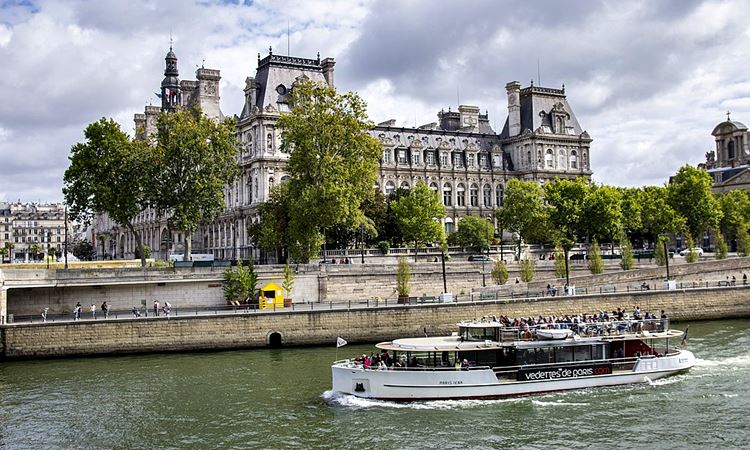
- Location: 3rd and 4th arrondissements
- Metro station: St-Paul (Line 1), Hôtel de Ville (Lines 1, 11), Pont Marie (Line 7), Rambuteau (Line 11)
Le Marais is a historic and cultural quarter of Paris. This Paris neighbourhood is home to grand mansions, secluded courtyards, elegant streets and a labyrinth of alleyways. There are also museums and art galleries. It’s also cool and lively with trendy shops, fashion boutiques and delectable eateries.
Le Marais is on the north side of the River Seine, partly in the 3rd arrondissement and partly in the 4th. There are several Metro stations where you can start to explore with St-Paul situated in the centre of the neighbourhood. Exit St-Paul and you’ll pass by grand mansions that were once owned by wealthy French nobles.
Historic sights include Hôtel de Ville (Paris City Hall), a famous landmark with its imposing Neo-Renaissance architecture. Place des Vosges is the oldest square in the city. Completed in 1605, it’s an elegant place surrounded by trees and gracious red brick buildings. Église Saint-Gervais is a splendid Gothic church from the 15th century.
Visit Rue des Rosiers, a narrow lane in an older part of Le Marais. Once home to Jewish-owned businesses but now mostly chic boutiques. The lane has not lost it’s old world charm though. The kosher eateries, pastry shops and falafel stands are still here. Nearby is Jardin des Rosiers, a small hidden garden surrounded by historic mansions.

Le Marais is literally packed with museums. The most prominent of them all is Musée Picasso, devoted to art by the famous Pablo Picasso. Housed in 2 big mansions is Musée Carnavalet, dedicated to the history of the city and free to visit. Musée Cognacq-Jay has a rare collection of fine art from the 18th century and is also free.
Marché des Enfants Rouges is at the junction of Rue de Bretagne and Rue Charlot. Opened in 1615, this is the oldest covered market in Paris. This buzzing place not only sells fresh foods but is also a great foodie stop. There’s a tasty range of street foods including French, Italian, Moroccan, Lebanese and Japanese cuisines.
When it comes to shopping, Le Marais is loaded with boutiques from big retailers to small independent shops. The best stops are on Rue des Francs-Bourgeois, Rue Vieille du Temple, Rue de Turenne and Rue St-Antione. Don’t miss Le BHV Marais on Rue de Rivoli, a huge department store with 7 floors of retail and over 2,000 brands.
Montmartre

- Location: 18th arrondissement
- Metro stations: Abbesses (Line 12), Anvers (Line 2), Pigalle (Lines 2, 12)
Montmartre is not the Paris you’d imagine. It’s a hillside village in a city, away from the 19th-century Hausmann buildings that glorify central Paris. This quaint village was once home to many artists in the 19th and 20th centuries with famous names like Renoir, Van Gogh, Modigliani, Utrillo and Picasso.
You can easily forget you’re in Paris when in Montmartre. The quarter is a muddled network of narrow cobbled streets, alleyways, hidden steps and old brick buildings. Visiting Montmartre is a walk up and down a hill. But you can always take a scenic ride on the little “trains” running between Place Blanche and Place du Tertre (near the top).
Montmartre has an old-fashion charm and village feel despite the hordes of tourists. Wander around and you’ll discover hidden gems. There are old churches, antique buildings, historic squares, small museums and secluded parks. What’s more, the local cafés are some of the cutest in Paris. If you’re in luck, watch a street performer.
Perched at the top of the hill is the famous Sacré-Coeur Basilica, an early 20th-century church with Roman-Byzantine designs and a huge dome. Take a steep walk up or ride the inclined funicular train in less than 2 minutes. The view of Paris from the top is simply breathtaking, more so during sunset.
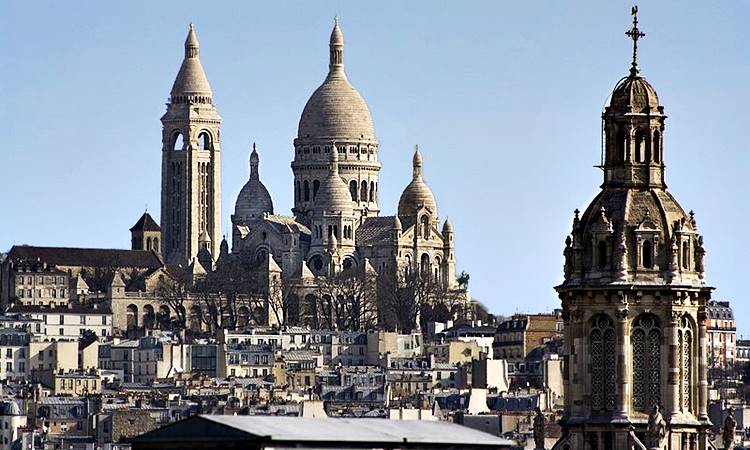
The main thoroughfare is Rue des Abbesses – exit Abbesses Metro Station and you’re right on the street. This dainty narrow street is packed with tiny shops, cute cafés and unpretentious bistros. That said, the stretch is charming and never a dull moment. On Sundays near the station, there’s a small bustling flea market with plenty to rummage.
Montmartre is an artsy place. And there’s no better spot than Place du Tertre, an open-air art gallery where artists sell their works. Musée de Montmartre was once home to famous artists like Renoir, Valadon and Utrillo. So, step inside and learn about the village’s history and admire paintings by the artists who once lived here.
There’s also shopping, mostly small independent shops selling everyday clothes and fashion without the luxury price tags. For cheap souvenirs for folks back home, look no further than Rue de Steinkerque. The alley is packed with tiny shops selling from “I Love Paris” T-shirts to refrigerator magnets.
Montparnasse

- Location: 14th arrondissement
- Metro stations: Montparnasse–Bienvenüe (Lines 4, 6, 12, 13), Raspail (Lines 4 and 6), Edgar Quinet (Line 6), Vavin (Line 4)
Montparnasse is a neighbourhood around Boulevard du Montparnasse, just outside the city centre in south Paris. It’s off the tourist radar except to visit a few key sights namely Les Catacombes de Paris and Tour Montparnasse. Or perhaps to Gare Montparnasse, to board the TGV trains heading to the west and southwest of France.
Meeting the dead “inside their graves” sounds bizarre. In the 18th century, cemeteries were overflowing. So 6 million skeletons were dug out and transferred into a maze of tunnels now known as Les Catacombes de Paris (Catacombs of Paris). Since 1809, visitors have been visiting the tunnel crypts. If you’re not squeamish, make a visit!
Montparnasse Cemetery is the second largest cemetery in Paris after Père Lachaise. Though not as famous but still a nice walk. The tree-covered cemetery is roughly 19 hectares (47 acres) and has more than 35,000 plots, some are simple while others are elaborate. Many of France’s intellectuals and artistic elites are buried here.
The Eiffel Tower is not the only place for a bird’s eye view of Paris. The Observation Deck on the 56th floor of Tour Montparnasse (Montparnasse Tower) offers an amazing view of the French capital and the Eiffel Tower. The rooftop terrace on the 59th floor is even more stunning with all-round views of the whole of Paris.

A short distance from Tour Montparnasse is Marché Edgar Quinet. This lively outdoor market opens Wednesdays and Saturdays on Boulevard Edgar Quinet. You’ll find a jumble of stalls selling fresh produce, gourmet foods and tasty street foods. Not only that, but there are also cheap clothes, scarves, jewellery, bags and odd knick-knacks.
The area near Tour Montparnasse is a foodie hotspot. The cafés, bistros and brasseries in the area offer really good value. Locations to explore include Boulevard du Montparnasse, Rue de la Gaité and Rue d’Odessa to name a few. Besides, there are the conveniences of shops and cheaper hotels if you plan to stay in this part of Paris.
Jardin du Luxembourg (Luxembourg Garden) is outside Montparnasse but next door. The park covers 25 hectares (62 acres) and goes back 400 years. This is one of the prettiest in the city and has the beauty of a royal garden. The park is a beautiful scene of formal gardens, landscaped trees, ponds, fountains and hundreds of sculptures.
Batignolles
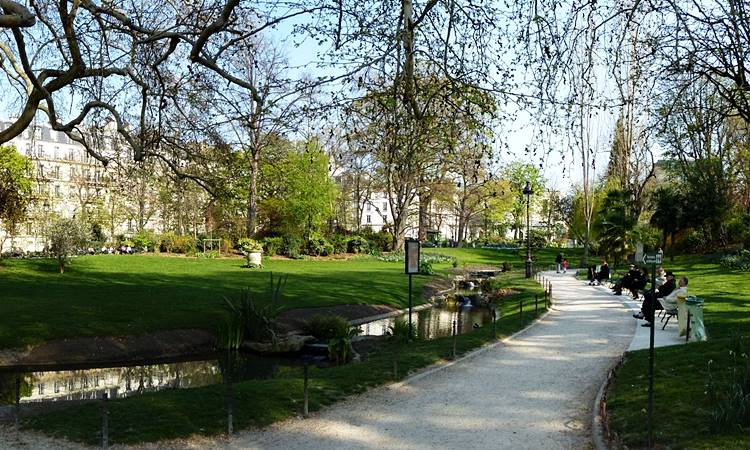
- Location: 17th arrondissement
- Metro stations: Pont Cardinet (Line 14), Rome (Line 2), Place de Clichy (Lines 2, 13), Villiers (Line 3)
Batignolles is snuggled in a quiet residential corner outside the city’s central area. With no big-ticket wonders, this is another part of the city that’s often overlooked by tourists. It’s laid back, humble and unpretentious. Batignolles may be unassuming but certainly charming and one of the best non-touristy neighbourhoods in Paris to visit.
The heart and soul of Batignolles is around Église St-Marie, a 19th-century church set in an adorable square. Most of the things to see and do are set around the square. Once regarded as humdrum and uneventful, it’s now the centre of life in the neighbourhood. Not a big area but a lovely walk to explore and enjoy your time.
Surrounding the square are fashion boutiques, quirky shops, cafés and bistros. This is where the locals gather. Hip and trendy but the pace is calm without the crowd of restless tourists. As a matter of fact, the setting is laidback and has a village feel. Nightlife here is modest and relaxed without the rowdy crowd.
Rue des Batignolles is the main street branching from the square and also the main shopping street. The walk is a delightful stretch of mostly 19th-century Haussmann architecture. Though there are some recent buildings, they blend graciously with the old architecture to retain its 19th-century charm.
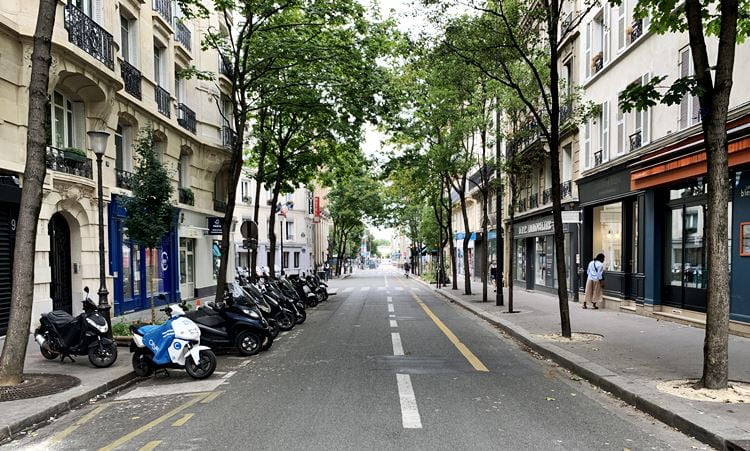
Batignolles is home to mostly independent retailers. Beyond shopping on Rue des Batignolles are Rue des Dames, Rue Legendre and Rue de Levis. You’ll find an array of what to buy from fashion to home décor. Though off the radar as a shopping destination for tourists, you’ll find a selection of popular French labels.
The neighbourhood is a culinary adventure filled with cafés and restaurants. There’s a wide choice of cuisines that will satisfy any taste from French to Thai. Check out the boulangerie and patisserie shops, they are without equal. The best areas for dining are Rue Brochant and Rue des Moines where you’ll find plenty of options.
Square des Batignolles is a small but pretty park between Pont Cardinet Metro Station and Église St-Marie. It’s a feature of manicured lawns, shady trees and grottoes. A stream meanders through and fills a pond, where Japanese carps and wildfowls make their home. There are paths for lovely strolls and plenty of benches to relax.

